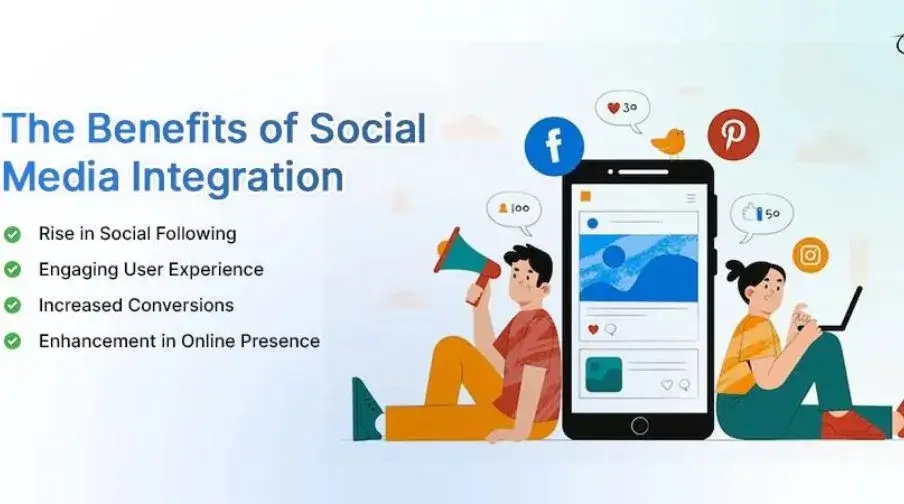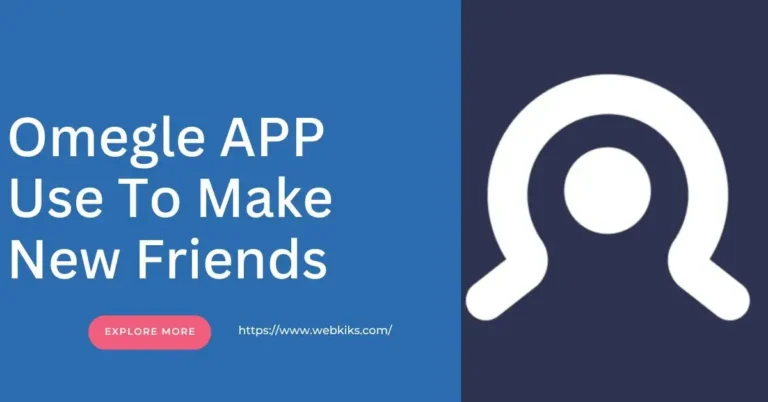Social media integration involves seamlessly incorporating social media platforms into your business strategy. But, this allows for a cohesive online presence, where content and interactions are unified across multiple channels. So, by integrating social media, businesses can enhance customer engagement, streamline communication, and amplify their marketing efforts.
Social media integration involves merging social media tools with business operations. This integration ensures that marketing, customer service, and sales efforts are consistent across all platforms. It also helps businesses build a unified brand identity, engage with a broader audience, and improve efficiency.
Integrating social media into your business strategy means connecting your social platforms with other digital tools. So this creates a seamless flow of information and interactions, enhancing user experience and brand consistency. Effective social media integration can boost engagement, increase reach, and streamline marketing efforts.
Social Media Integration Strategy In 2024
Social media integration in 2024 involves seamlessly blending social media channels with broader marketing and business strategies. So, it helps to maximize engagement, brand presence, and customer satisfaction. Here are the critical components of an effective social media integration strategy for 2024:
Perfect Channel Experience
Consistency Across Platforms: The first is to ensure consistent branding, messaging, and customer experience. It needs to be added across all social media platforms and customer touchpoints. Therefore, linking social media platforms helps to facilitate easy integration.
Unified Customer Data: The perfect branding and integration need perfect customer data. So, you need to integrate social media data with CRM methods to view customer interactions and preferences.
Advanced Analytics and AI
Predictive Analytics: AI is the best advancement for promoting social media. Therefore, AI can analyze social media trends and predict customer behavior, enabling more targeted marketing efforts.
Sentiment Analysis: Real-time user experience is also easy to add to the analytical system. So, with this, you can check your customer’s and users’ reaches. But to implement tools to gauge customer sentiment in real-time and adjust strategies accordingly.
Personalization At Scale
Dynamic Content: Content is vital to improving and making social media integration easy. However, AI should be improved to deliver personalized content to users who are set on social media activity and preferences.
Custom Audiences: Traffic and user leads for social media are necessary to improve branding and sales. However, it is good to add and create custom and unified users. Therefore, creating and targeting specific audience segments with tailored messages and offers is important.
Social Commerce
In-app Purchases: Enabling customers to purchase products directly within social media apps streamlines the shopping experience and makes it easy for customers to buy.
Shoppable Posts: To use features like Instagram Shopping and Facebook Shops to turn posts into direct sales opportunities. It helps to make good leads and add new posts in a shippable form. Thus, it is good to add posts manually and make customer reach.
Influencer Collaboration
Micro-Influencers: Macro and micro-influencers help to make social media marketing for all social media platforms. But, it is good to partner with micro-influencers with highly engaged niche audiences for more authentic and cost-effective campaigns.
Long-term Partnerships: Build relationships with influencers to create more credible and impactful brand advocacy. This helps make content creation easy and easy to use on all social media platforms, such as Facebook, Instagram, Messenger, LinkedIn, WhatsApp, and others.
Best Social Media Integration Tools In 2024
A social media integration tool is software designed to connect and streamline your social media accounts with other digital platforms and business processes. These tools help manage, monitor, and analyze social media activities from a single interface. So, they allow businesses to schedule posts, engage with followers, track performance metrics, and integrate social media data with other marketing, sales, and customer service systems.
1: Flocker
Flocker is a social media management tool designed to make content creation and scheduling across multiple platforms. It offers a user-friendly interface for planning posts, collaborating with team members, and managing social media campaigns. Flocker’s analytics feature helps track engagement and measure the performance of your social media efforts, making it easier to refine strategies and improve results.
2: 1Password
1Password is a password manager that ensures the security of your social media accounts by storing all your login credentials in one place. It offers password generation, secure sharing, and multi-factor authentication to secure your accounts from unauthorized access. To simplify password management, 1Password helps businesses maintain strong security practices and prevent social media breaches.
3: Mobilocard
Mobilocard is a digital business card solution that integrates with social media platforms, is allows users to share contact and social media accounts seamlessly. It helps professionals and businesses enhance networking by providing a quick and easy way to connect on social media. Mobilocard’s analytics features also offer insights into how and when your digital business cards are used, helping you measure networking success.
4: SmartrMail
SmartrMail is an email marketing tool that integrates with social media to enhance your marketing campaigns. It allows you to create and send personalized email campaigns while incorporating social media links and content. SmartrMail’s automation and segmentation features ensure that your emails reach the right audience, boosting engagement and conversion rates.
5: FusionAuth
FusionAuth is an authentication and user management platform that supports social media login integrations. It allows users to sign in to your applications using their social media accounts, streamlining the registration process and improving user experience. FusionAuth also provides robust security features, including multi-factor authentication and user activity monitoring, to protect your users’ data and enhance overall security.
How To Create A Social Media Integration Strategy?
Ideally, making your social media leads and traffic for branding is good. You must create a proper social media strategy and get more traffic to all your channels. Some points give a perfect solution for your social media integration.
Describe Your Goals
Begin by setting clear goals for your social media integration strategy. Determine if you want to:
- Increase brand awareness
- Drive traffic to your website
- Boost sales
- Improve customer engagement
Knowing your goals helps measure success and shape your integration strategy.
Select Social Media Platforms And Marketing Channels
Focus on social media platforms and marketing channels that align with your goals and audience. Popular platforms include Facebook, TikTok, Reddit, Instagram, Pinterest, Twitter, LinkedIn, and YouTube. Integrate your marketing efforts with social media through your website, email campaigns, and digital signage.
Experiment With Integration Process
Try different methods to see what works best for your brand. Use your goals to guide the process:
Live Social Feeds: Embed live feeds on your website to showcase user-generated content.
Shoppable UGC: Encourage customers to share content featuring your products with links to buy.
Embed Reviews and Mentions: Display customer reviews and positive social media mentions across your website and emails.
Social Media Icons: Place icons prominently on your website, emails, and digital signage. You should also add unique icons to social media platforms like Facebook, Messenger, and Instagram.
Social Login: Allow users to log in or sign up with their social media accounts. It helps to improve sales and can add accounts for leads.
Social Sharing Buttons: Include sharing buttons on your blog for easy content sharing. In addition, all your posts and content are best shared on all platforms.
UGC and Lead Collection: Use forms to sign up users for social media challenges, giveaways, and contests. Collect data for your sales and leads quickly.
Consider using tools like Flockler, 1Password, Mobilo, SmartrMail, and FusionAuth.
Use Analytics To Improve
Analyze behavioral and social media data to refine your campaigns. Continuously test, measure results, and adjust to optimize your strategy. Every brand is unique, so find what resonates with your audience and helps you reach your goals.
Wrap It Up
Is it ready to enhance engagement and expand your online presence with social media integration? Save this guide, share it with your marketing team, and take the time to implement these strategies. By aligning with your goals and refining your approach, you can build deeper connections with your audience and achieve growth.
Benefits of Social Media Integration
Increased Brand Awareness
Social media integration enhances your online presence, making your brand more visible to a larger audience. So, this exposure can lead to greater recognition and recall among potential customers.
Enhanced Customer Engagement
Integrating social media creates more touchpoints for interaction, fostering stronger connections with your audience. Moreover, customers are more likely to become loyal advocates for your brand.
Improved Website Traffic
Sharing content across social media platforms drives more traffic to your website. So, this influx of visitors can lead to higher conversion rates and more sales opportunities.

Boosted Sales
Integrating social media with your e-commerce efforts can directly influence purchasing decisions. Shoppable posts and user-generated content showcasing real-life product use can encourage more purchases.
Streamlined User Experience
Social login options simplify the registration process for users, leading to higher sign-up rates. A smoother user experience can improve overall customer satisfaction.
Real-time Customer Feedback
Social media is to provide instant feedback from your audience, allowing you to address concerns and adapt your strategies quickly. This responsiveness can enhance your brand’s reputation and trustworthiness.
Better Analytics and Insights
Social media analytics offer perfect insights into customer behavior and preferences. These data-driven insights help refine your marketing strategies for better results.
Increased Reach
Leveraging multiple social media platforms extends your brand’s reach to a broader audience. This widespread presence can attract diverse customer segments and expand your market.
Conclusion
Integrating social media into your marketing strategy is essential in 2024 to enhance brand awareness, engage customers, and drive sales. By defining clear goals, selecting the right platforms, experimenting with various integration techniques, and using analytics to refine your approach, you can effectively harness the power of social media.
This strategic integration helps create deeper connections with your audience, boosts online reach, and supports your business growth. Hence, start implementing these strategies today to stay ahead in the competitive digital landscape.
Frequently Asked Question
What Is A Social Media Integration Strategy?
A social media integration strategy involves incorporating social media channels into your broader marketing efforts to enhance engagement, brand visibility, and sales. It includes linking your social media profiles with your website, email promotions, and other marketing channels.
Which Social Media Platforms Should I Focus On In 2024?
It needs to focus on platforms that align with your target audience and goals. In 2024, popular platforms include Facebook, TikTok, Instagram, Twitter, LinkedIn, Pinterest, Reddit, and YouTube. Analyze where your audience is most active to prioritize your efforts.
How Can Social Media Integration Increase Website Traffic?
You can drive more visitors by sharing engaging content on social channels and including links to your website. Features like social sharing buttons and embedded social media feeds can also help direct traffic from social media to your website.
What Are Some Effective Social Media Integration Strategies?
Effective strategies include:
Embedding live social feeds on your site
Using shoppable user-generated content (UGC)
Adding social media reviews and mentions to your website and emails.
Placing social media icons on various channels
It offers social login options and social sharing buttons on your blog.
How do I Measure the Success of My Social Media Integration Strategy?
It is good to use analytics to track website traffic, engagement, conversion, and sales. Monitor social media insights to understand audience behavior and preferences. Moreover, you need to adjust your strategy based on these data-driven insights.
Can Social Media Integration Help Improve Customer Engagement?
Integrating social media can create more opportunities for interaction with your audience. Responding to comments, sharing user-generated content, and running it on social media contests and challenges can foster a stronger connection and build a community around your brand.





